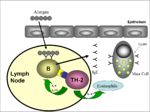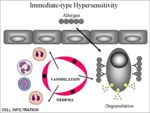Difference between revisions of "Type I Hypersensitivity"
Jump to navigation
Jump to search
| Line 71: | Line 71: | ||
*Immediate reaction | *Immediate reaction | ||
*Includes: | *Includes: | ||
| − | **[[ | + | **[[Atopy|Atopic dermatitis]] |
| − | **[[ | + | **[[Urticaria]] |
**Angioedema | **Angioedema | ||
**Fly bite hypersensitivity | **Fly bite hypersensitivity | ||
Revision as of 16:45, 22 February 2011
| This article has been peer reviewed but is awaiting expert review. If you would like to help with this, please see more information about expert reviewing. |
Introduction
- Also known as IgE-mediated or anaphylactic hypersensitivity.
- Ranges from mild cases, such as hayfever, to life-threatening reactions, such as bee-stings.
- Antigens that induce a type I reaction are known as allergens.
- Generally affects face, eyes, nose and feet
- IgE has a high affinity to IgE receptors on mast cells and basophils, and so binds these receptors.
Common allergens which elict a type I hypersensitivity reaction:
- Proteins : Foreign serum
- Plant pollens : Rye grass, ragweed, timothy grass, birch trees
- Drugs : Penicillin, sulphonamides, local anaesthetics, salicylates
- Foods : Nuts, seafood, eggs, milk
- Insect products : Bee venom, wasp venom, dust mites faeces, flea saliva
Mechanism
1. Initial antigen exposure sensitises immune system (Image 1):
- Allergen exposure causes IgE production.
- IgE coat mast cells by binding to Fc receptors.
- Mast cells are now sensitised to this particular allergen.
2. Subsequent exposure to the specific allergen (Image 2):
- Mast cells degranulate.
- Basophils with IgE receptors are recruited and also degranulate.
Mast cells secrete mediators:
- The release of inflammatary cytokines which can cause the dog to become itchy.
- Steroid mediators, e.g. prostaglandins and leukotriens
1. Chemoattractants (attracts mainly neutrophils but also eosinophils, monocytes and basophils and plasma)
2. Vasoactive and inflammatory peptides (e.g. histamine and serotonin) which causes acute contraction of smooth muscle fibres
- If the allergen is inhaled (locally) it can lead to bronchoconstriction.
3. Mucus production - due to the release of mast cell proteases
4. Vasodilation (leads to redness and heat).
5. Oedema (from leaky blood vessels).
3. The late phase response:
- Mediated by eosinophils.
- Takes longer (several hours) as the eosinophils are mobilised from the bone marrow.
Examples of Type I hypersensitivity
From Pathology
- Mediated by pharmacologically active substances from mast cells and basophils
- Due to antigen-antibody (usually IgE) binding to receptors on those cells
- Substances include histamine, serotonin, leukotriens, prostaglandins
- Can be systemic or local
- Skin becomes pruritic, raised erythematous borders of wheals
- Immediate reaction
- Includes:
- Atopic dermatitis
- Urticaria
- Angioedema
- Fly bite hypersensitivity
- Gastrointestinal parasites
- Food
- Microscopically:
- Capillary dilation, oedema, mast cell degranulation, eosinophil infiltration

